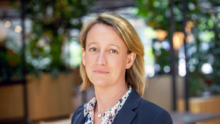Anne-Sophie Castelnau has been global head of Sustainability at ING since 1 April 2021. Here, she talks about ING’s integrated approach to climate and what she thinks of the job so far.
What’s so special about this report?
It shows ING’s really holistic approach to climate action. As a bank, our biggest impact is with our financing, so we’ve been steering that for several years. But we also have to look at the impact of the climate on our business. What kind of risks there are, whether we’re resilient enough to those risks. Also importantly, our clients are also all at risk from climate change, so we engage with them around that topic, advising them on financing. In this report, that all comes together.
If we only remember a few things from this report, what would they be?
One, that ING’s taking action on climate financing and climate risk, and really adding value for our clients in both areas; two, that we’re using science-based methodologies to steer our portfolio towards climate goals and continued our good work last year, with most sectors in scope on track to meet them; and three, we aim to decrease funding to upstream oil and gas by 12% by 2025, which is a new, intermediate target that can help us steer and be held accountable.
Why do we only have an updated target on net zero by 2050 for oil and gas, and not any of the other sectors?
Our approach is to define targets based on reliable data and scenarios. Last year we announced a target to reduce funding to upstream oil and gas by 19% by 2040. At the time, we said we’d update that target whenever the International Energy Agency updated its scenarios. They did that this past May for oil and gas, so we went for that update.
How will we achieve this 12% reduction?
We’ll work towards the target by reducing our exposure to energy types that are carbon-intensive and steering towards cleaner energy types. In general, we believe in facilitating change by engaging with our clients. And as our portfolio of loans has a duration of four to five years, we have multiple occasions to engage with them on their direction. Actually talking to them, seeing what their struggles are, and advising them on how to help contribute towards the energy transition. Then we help them fund those changes. Things like developing new products and services, decarbonising their operations, and especially investing in new energy technologies. Only saying ‘no’ would be the easy way. They would just go to another bank, who might not be as interested as we are in helping to fight climate change.
How does climate risk play into our approach?
Risk is a part of every bank’s business model. Every time we give a loan, we’re calculating the risk of not being repaid. And we’re required to keep a certain amount of money on our books to ensure we stay in business if they aren’t. This is guided by regulation. Climate risk is becoming more and more important as climate change could have an impact on our clients and the assets we finance. Which means that there are new regulations being worked on and new risk models needed. You can’t look at financing anymore without also looking at climate risk.
What kind of risks are we talking about?
There are the obvious physical risks, like what happens to our Dutch mortgage portfolio if parts of the country would flood. But there’s also transition risks, the risk of things like stranded assets. For example, what will happen to companies if they don’t adjust their business models enough to deal with climate change. Take carmakers. If they don’t start making any electric vehicles, what will happen to them once the law says that only electric vehicles can be sold. They will have ‘stranded assets’. That’s an over-simplified example but it gives an idea of what I mean.
So what are we doing?
Well, we’re trying to become more resilient to those risks. We have to identify them, assess them, understand the impact they could have on our business and try to look for ways to mitigate that. We use scenarios for that, and stress-testing. What we learn helps us make our business decisions. We do this as part of our risk management framework. And how we do this continues to evolve in line with developing regulations and methodologies. This is exactly why our inclusive approach around climate change is so important. Only through engagement with our clients are we able to detect the right risks and with that, also support them in becoming more resilient.
We’re just one bank. How can we make a difference?
We can definitely make a difference, but we can’t make a difference alone. First, our clients are our partners in this, they have to be willing to evolve with us to a low-carbon world. To look at their business, see what they can improve on, and actually make those changes. And second, all of us rely on governments to play their part too. We need stronger, bolder regulations that require and support the necessary changes. As we like to say, it takes three to tango when it comes to climate action. It has to be a united global effort.
You’re relatively new to the role – what stands out for you?
I joined from Wholesale Banking, so I’ve seen first-hand over the years how clients have been shifting towards prioritising sustainability. What stands out for me is the passion I see throughout ING for the topic, and the leadership role ING has in measuring and steering our portfolio. That’s something I’m really proud of.






